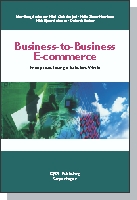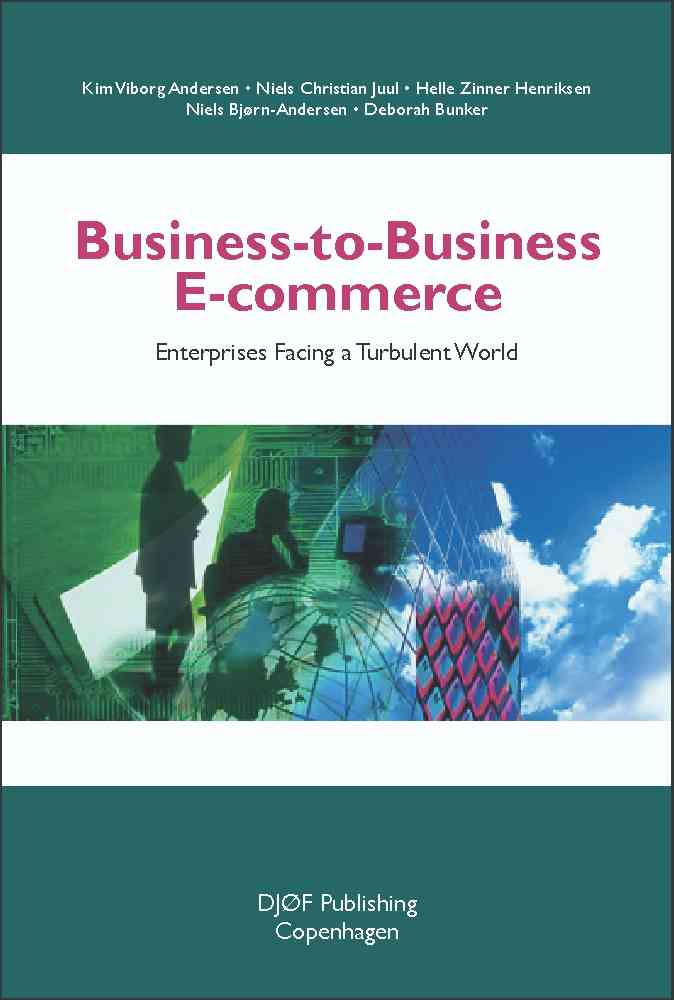Copenhagen Business School
| More information |
|
Publications |

Business-to-Business
E-commerce:
Enterprises Facing A Tubulent World?
by
Niels Christian Juul
Helle Zinner Henriksen
Niels Bjørn-Andersen
&
Deborah Bunker

E-commerce is a cornerstone in the transformation of the economy to the networked economy. The majority of the e-commerce applications are exploited in the business-to-business relations. Various estimates suggest that 80% or more of the total e-commerce value is allocated in the business-to-business segments.
Although e-commerce often is portrayed as an entire new invention and bringing endless new choices, our proposition here is that it is useful to look back at the actual e-commerce applications that has dominated the scene during the past 3-4 years. It is our proposition here that it might be wise to reflect on the technical choices for companies and critical access whether the increasing appearance of exchanges and marketplaces (Ariba, CommerceOne, Industrilink.dk) and add-ons (to for example Oracle, SAP, Axapta, and Navision) actually has decreased the uncertainties within the business-to-business segment.
Electronic Data Interchange (EDI) is the technology that has been the far most applied e-commerce solution so far. Several authors have referred to EDI as the forerunner for e-commerce (e.g. Wigand, 1997 and Zwass, 2000). With this book we hope the readers ask themselves three set of questions:
-
How different is the e-commerce situation today facing functions, companies and business networks compared to four, three, two, or one year ago? Given difference in the current e-commerce challenge, what impacts does this difference have?
-
Given a different pattern in EDI-diffusion during the past four years in the various business segments, what are the policy implications of this for businesses, business network, business associations and governmental regulation and operations?
-
Looking at the methodology developed and used in this book, we encourage the reader to address whether similar analyses could be conducted on the current e-commerce development?
Our three questions hopefully stimulate the ongoing e-commerce management within our focus groups for this book: decision-makers in companies, interest groups, policy settings, managers, consultants, as well as students within the business and IT area.
This book was commenced in January 1998 and finished during the summer 2000. Our focus is on, e-commerce in the private and public sector. In this book, e-commerce comprises digital communication between businesses, including internal communication in groups of companies (business-to-business), with public authorities (business-to-administration), but not with consumers (business-to-consumers). A subset of e-commerce is EDI. Here EDI is applied in the broadest sense, comprising all types of structured electronic interchange of data.
Our book compromises a total of seven chapters. In chapter one we outline a definition of e-commerce. Our rather broad definition embraces practically any digital, structured activity between companies and between companies and the public sector. Furthermore do we elaborate on how information technology has been interpreted in the organizational setting. Two views, the utopian and the anti-utopian, are presented. We find that this theoretical approach to e-commerce is important because information technology plays a key role in e-commerce. However, e-commerce is more than a technological tool. We point in chapter one to the notion of seeing e-commerce in an objective, a process, and a power perspective when accessing how and why e-commerce is adopted within the organization and diffused in a particular business sector. We do not suggest that there is a single explanation to the question. It is however, relevant to keep in mind that different types of forces influence the diffusion of e-commerce.
In Chapter two we present the Danish EDI Agenda as it was formulated in 1996 and discuss the overall dilemma governments and business associations encounter in their involvement in diffusion processes. Government and business associations have a variety of options when aiming at stimulating e-commerce. In Chapter two we group these actions in two overall modes: direct or indirect mode. The intervention can be by pedagogical, economic, normative, or organizational excellence. In the action plan, the chosen path was to take primarily indirect actions and only marginal direct actions. In the chapter we discuss the balance between ideas and realities on e-commerce during the period 1995-1999 and conclude the chapter with the current changes in the e-commerce action plan.
Departing from the policy issues, we provide in chapter three a classification scheme, we have erected as a basis for the empirical research on EDI. We present the VIDS-test (Volume, Integration, Diversity and Span) used for evaluation of the EDI usage.. Also, we present our classification scheme for proprietary EDI, EDIFACT and browser-EDI.
Chapter four, five and six contains our core empirical results. In Chapter four we analyze the third-party EDI-traffic, that is the EDI traffic that is transmitted through the VANS-operators lines. Using the EAN-indicator, we present data on number of companies able to send EDIFACT-message. Chapter five addresses the business-to-business EDI transaction in four main sectors of the economy: production, commerce, transportation, and financial and service sector. Chapter six address the business-to-administration e-commerce in central and local government as the health sector.
We conclude the book in Chapter seven with conclusions on the keys themes in the book: 1) the balance of objectives, processes and power in e-commerce solutions, 2) The VIDS-test, 3) the EDI diffusion, and 4) the potential for future growth in EDI.
The researchers are greatly indebted to the VANS operators for providing unique access to data on their EDI-traffic. Also, we are indebted to the companies and public organizations for their readiness to cooperate and participate in the interviews.
The researchers would also like to thank the following research assistants: Lotte Mangor, M.Sc. student in International Economics and Management; Tine Bjørn-Andersen, M.Sc. student in Economics and Business Administration and Nina Christiansen, Ph.D.-student in Business Administration and Computer Science, who have assisted in processing the data collected as well as arranging and conducting interviews.
It is the authors, however, who are solely responsible for the report: Associate Professor Kim V. Andersen (project manager), Associate Professor Niels Christian Juul, Professor Niels Bjørn-Andersen, Ph.D.-student Helle Zinner Henriksen, all at the Department of Informatics, Copenhagen Business School and Deborah Bunker, School of Information Systems, Technology and Management, University of New South Wales (UNSW), Australia.
We have reported our findings in several articles and booklets all published prior to this report. The abstracts, data tables and our reports are available at the website URL http://www.cbs.dk/cips/edi/.
The study was in part funded by the Danish Center for IT Research (www.cit.dk) and the Danish EDI Council (www.edi.dk).
Frederiksberg, September 3, 2000
Kim V. Andersen
Niels Christian Juul
Helle Zinner Henriksen
Niels Bjørn-Andersen
Deborah Bunker
File: last updated
by Niels Christian Juul.